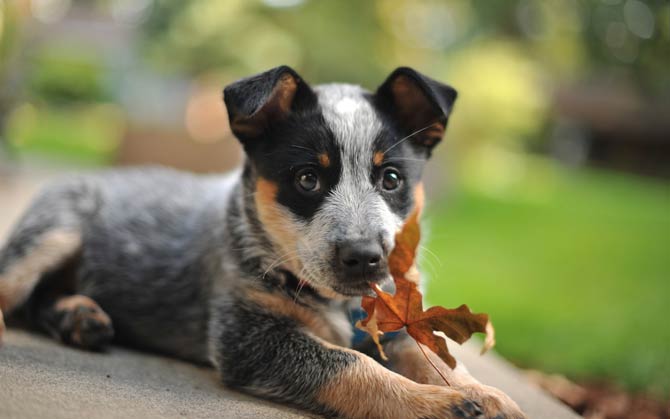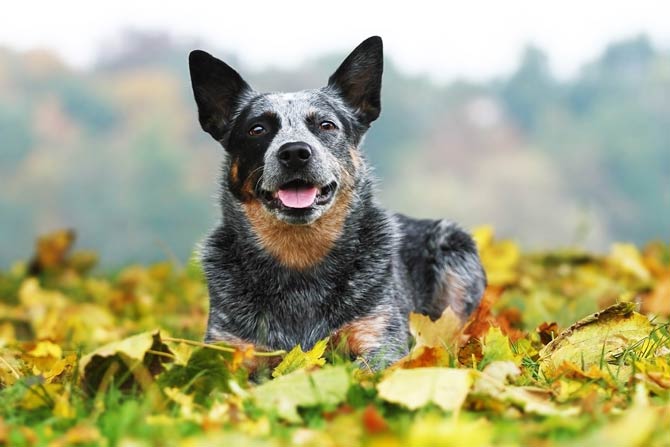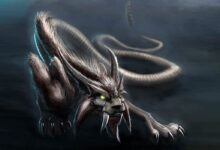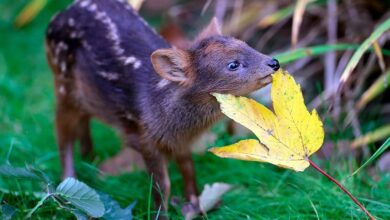Dog breeds – Australian Cattle Dog (ACD)
A crossbreed between domestic dog and dingo
A real soldier among dogs, who with his stubbornness, charisma and endurance can tame the most resistant farm animal. In relation to humans, it can be equally stubborn, but with the good attitude of the owner, it turns out to be a devoted, loving companion and protector of the human herd. Here is a crossbreed of a domestic dog and a dingo – the Australian Cattle Dog.
FCI classification:
- Group 1 Sheepdogs and Cattledogs, except Swiss Mountain and Cattledogs
- Section 2 Cattledogs
- Without working trial
- Color: Black, black and tan, red, red and tan, fawn, chocolate, smoke blue
- Nicknames: Red Heeler, Blue Heeler

History and origin of the breed
In the 19th century, English breeds were brought to Australia and interbred with dingoes. However, the modern form of Australian Cattle Dog is the result of the multiple crossing of various races. The farmers there needed extremely durable dogs, resistant to very high temperatures and adapted to hard work in difficult terrain. Pure European breeds such as the Old Smooth Collie (not the modern Scottish Sheepdogs) were not suitable for this.
The modern character of ACD is a combination of dingoes with Dalmatians and black Australian Kelpie. Some sources also mention bull terriers.
The breeding of ACD was taken care of by the 19th century Australian settlers. The main task of the dogs was to guard the herds of semi-wild cattle that had been grazing over vast areas for a long time. To control somewhat aggressive livestock, ACDs frequently gnawed and pinched their charges’ limbs.
Blue Merle (marbled) turned out to be the most popular ACD variety among farmers. It even received a separate name – Blue Heelers. An alternative name – Queensland (Blue) Heelers – is due to popular cattle routes in Queensland.
At the end of the 19th century, a certain Robert Kaleski, who was engaged in breeding the breed, developed a model for it based on a cross between a domestic dog and a dingo. He believed that such a genetic combination was best for working in the endless areas of Australia. It is easy to see that apart from the color of the coat, modern ACD resembles a dingo.
The Kennel Club of New South Wales approved the breed standard in 1903. The AKC classified it to the working breed group in May 1980, but it was transferred to the herding breed group in January 1983.

Characteristic
Appearance
ACD is a very strong, agile and enduring dog. Muscular, compact figure helps him a lot in hard work. The length of the body is clearly greater than the height at the withers. On the rump, a low-set tail is visible, forming a delicate arch. The front legs are straight, strong, ending in rounded paws with short fingers. The skull is wide, slightly rounded between ears. The ears, on the other hand, are set wide apart, set not too high but also not too low, moreover protruding and very mobile during activity.
The coat consists of two layers: a dense and short undercoat, and a straight, compact and close-fitting topcoat to protect against rain. It appears longer and denser on the lower body, thighs, head and neck.
The FCI distinguishes between two color varieties:
Blue – dogs can be blue, blue mottled, or blue speckled with tan on the legs and chest and white markings and a black patch or “mask” on one or both sides of the head.
Red – dogs are evenly speckled with solid red markings and similarly to the blue dogs can have a brown (red) patch “mask” on one or both sides of the head and sometimes on the body.

Temperament
Like other working breeds, the ACD is characterized by its enormous energy resources, active mind and clear independence. Because of this, it needs a lot of movement, tasks to perform and human company. Non-breeders can take part in many dog sports, which will stimulate them both physically and mentally.
As a pet, they are distinguished by their inner joy, devotion and love of playing. However, when confronted with a stranger, ACD shows suspicion. It is easy to see this from his gaze, in which joy and cleverness are replaced by vigilance. Due to its large reserve in relation to strangers, it works well as a watchdog. These skills are worth grinding with the help of appropriate training. However, if we want him to be more friendly towards family friends, it needs to be socialized from an early age.
ACD lives in harmony with older children, but in contact with younger, active children, it shows shepherding behavior (it may nip the baby’s heels to guide him).
The Australian shepherding dog establishes a strong bond with the owner, so it is not used to distance itself from him too far. It also shows a strong need for protection. Although it is usually friendly, it reacts quickly to changes in the mood of his guardians. Therefore, it happens to react with defense without an explicit command.

Nipping heels
Keep in mind that the breed was bred to herd uncooperative cattle and therefore has a tendency to bite on the heels of “disobedient” humans. This behavior, disregarded during the puppy period, can turn into dangerous behavior in adulthood.
Barking
ACD works in silence, but barks when it wants to attract attention. It is distinguished by a characteristic, squeaky timbre of voice. Barking alongside the unsuitable owner can be a symptom of boredom and frustration. However, it appears that the more frequent ACD vocalizations are due to noisy company.
She reacts calmly to familiar dogs, but if there are several of them, the meeting may end with aggressive attempts to establish a hierarchy. The ACD is therefore not suitable for living with more than one dog. Although there are cases of bites and other attacks on humans within the race, it is a negligible percentage of similar cases (approx. 0.1%). Staffordshire Bull Terriers and German Shepherds take part in this type of activity much more often.

Health condition
The most serious disease in the breed – deafness – is closely related to the genes responsible for the white color of the coat and skin. Based on the research, it was shown that about 2.5% of ACD dogs suffer from bilateral deafness, while in about 14.5% of representatives of this breed, one-sided deafness was detected.
Progressive retinal atrophy is also common. In ACD dogs, this form of the disease is characterized by deterioration in vision in late adulthood, which leads to blindness.
Hip dysplasia is not very common, but diseases of the spine, infertility, uterine diseases, pseudopregnancy and the aforementioned blindness are quite popular diseases within the breed. According to studies from the USA and Canada, the most common causes of veterinary intervention in ACD are bone fractures and damage to the cruciate ligament.

Detailed data / size
Australian Cattle Dog (ACD)
- Height at the withers:
- Males: 46–51 cm (18–20 in)
- Females: 43–48 cm (17–19 in)
- Weight: 15–22 kg (33–49 lb)
- Lifespan: 11-16 years (Bluey – the oldest ACD dog lived 29.5 years)

Australian Cattle Dog – interesting facts
- Stanley Coren placed the breed at the 10th position of the most intelligent dog breeds. This means that the ACD dog is one of the most intelligent breeds in terms of obedience and ease of learning.
- The most important role of Australian Cattle Dogs is to encourage (or rather force) reluctant cattle to travel long distances. It is believed to be the best breed for this type of work. Some cynologists argue, however, that the modern strain is not as effective as in the past, because its limbs are too short for its stocky body.
- Most of the breed’s representatives are very fond of water and swim very well.
- The oldest known ACD dog was Bluey, who was born in 1910 and died 29.5 years later. However, the story of this age-old dog has not been confirmed by evidence.
- In addition to herding cattle, the ACD works well as a therapy dog for people with disabilities, police and drug detection.



















